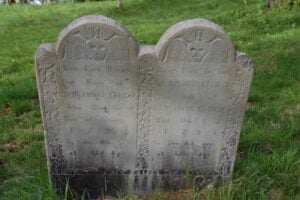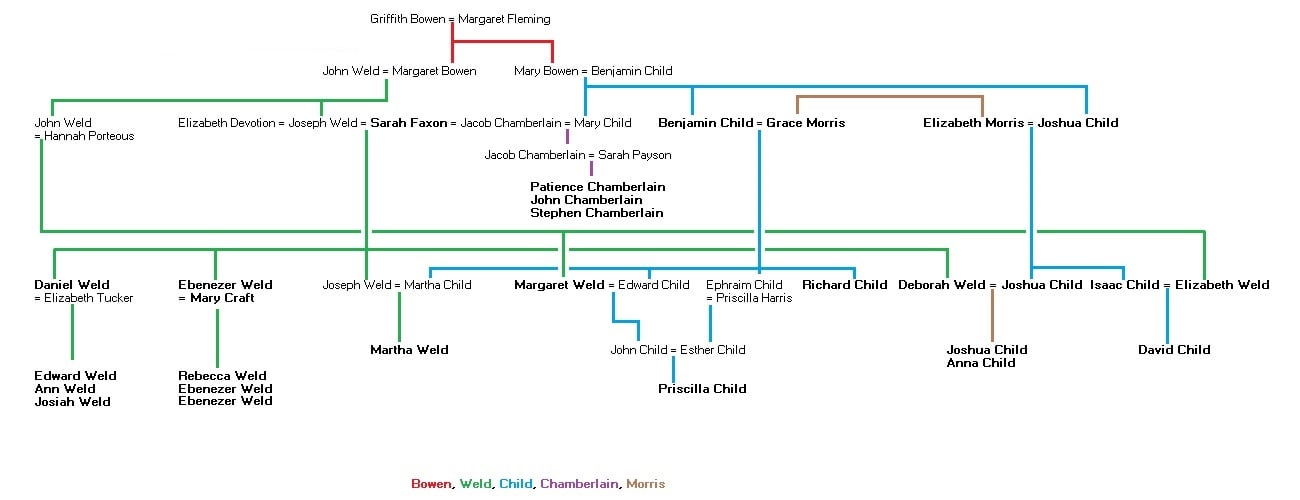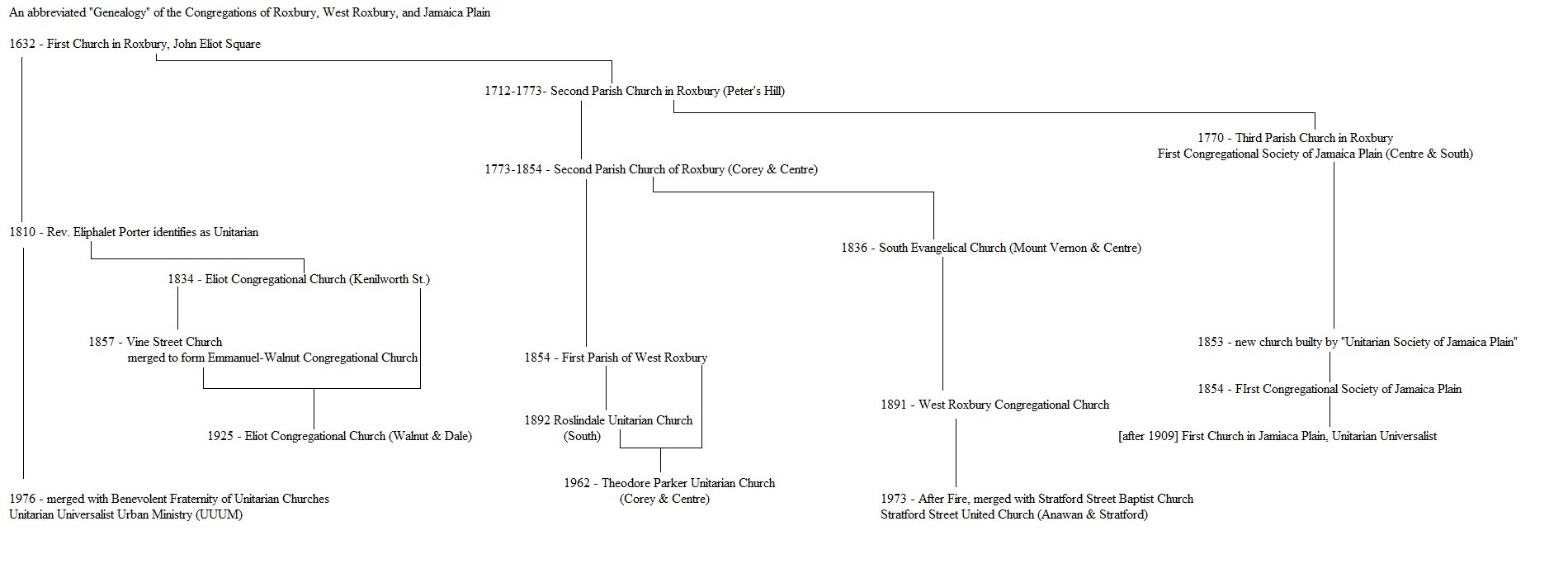My recent post about distant Child cousins living in the Boston area who were early members of NEHGS reminded me of another genealogical (and geographical) connection. Near my home in Boston’s Jamaica Plain neighborhood, there is a very small cemetery—known as the Walter Street Burying Ground—within the Arnold Arboretum (leased from the City of Boston and maintained by Harvard University) that only has ten stones standing. Frequently friends and colleagues who notice these graves will see the “twin stone” at left, of Benjamin and Grace Child, and ask me if there is any relation. Why, yes, there is!
The farm of my patrilineal immigrant ancestor Benjamin Child (1631/32–1678) in Roxbury, Massachusetts (now Boston, in Jamaica Plain), borders the town of Brookline. The farm went to Benjamin’s son Benjamin Child, Jr., buried above with his wife Grace. This junior Benjamin is my first patrilineal ancestor born in North America. Right next to Benjamin and Grace is Benjamin’s brother Joshua, who is also my ancestor. Joshua’s wife Elizabeth (a sister to Grace), is also buried there, but her gravestone does not survive.
While most of the senior Benjamin’s grandchildren moved to New Roxbury, Massachusetts (now Woodstock, Connecticut) in the late 1600s and early 1700s, a few descendants remained in Roxbury and Boston, including the branch of relatives who were early members of NEHGS. This farm stayed in the Child family until 1853, when Stephen6 Child (Stephen5, John4, Edward3, Benjamin2-1) sold the land. After a series of sales during the next two decades, the land was purchased by the shipping magnate William Fletcher Weld (1800–1881), and ultimately went to Weld’s granddaughter, Isabel Weld Perkins (1876–1948), who married the diplomat Larz Anderson (1866–1937).[1] This wealthy and childless couple willed their Brookline and (immediately adjacent) Boston lands to the town of Brookline, and the “Benjamin Child farm” is now part of Larz Anderson Park and Auto Museum. My daughters have had several birthday parties in this park, which is additionally fun for its ancestral connection.
[The] “Benjamin Child farm” is now part of Larz Anderson Park and Auto Museum.
Going back to the Walter Street Burying Ground, several years ago I gave a talk at the Loring Greenough House about this cemetery. This 1760 home in Jamaica Plain was a military hospital during the Revolutionary War, and in 1775 and 1776 many soldiers who died from smallpox were buried outside the house. The graves were discovered in 1867 and moved to this cemetery, and then rediscovered in 1902 when they widened Walter Street, which gave way to a military monument at this cemetery, as well as a third reinterment of these smallpox victims to Mount Hope Cemetery elsewhere in Boston. But back to the original cemetery!
This was the original cemetery of the Second Parish Church of Roxbury, which only operated 1712–73. The original English settlement of Roxbury was centered around what is today known as John Eliot Square, and this first parish church in the center of the town was formed in 1632. As more residents lived in the western part of the town, there came a need for a second parish closer to where they lived, and these residents petitioned for a second church in 1706. This parish was established on land donated by Joseph Weld (1650–1711/12), another of my ancestors (and an ancestor of William Fletcher Weld, above).[2]
A third parish church was created in 1770 (in the center of Jamaica Plain today), but as the second and third parish churches were a bit too close, the second parish moved further into West Roxbury, where it stands today. (It was later known as the First Parish of West Roxbury.) The church stood at the top of what is now known as “Peters Hill,” which now has great views of downtown Boston. The original second parish cemetery had 41 burials during its time between 1722 and 1768, with twelve burials between 1776 and 1857, after the church moved. Today only ten graves stand; fortunately, all the gravestone inscriptions were abstracted in an early 1854 issue of the Register. I’m related to the overwhelming majority of the people buried there, with this chart showing the buried people in bold descending from my Bowen, Weld, Child, Chamberlain, and Morris ancestors.
Shortly after the second parish moved, these Congregational churches were affected by the Unitarian Movement in the United States. As New England congregations “went Unitarian,” a Congregational church would often be created elsewhere. These three Roxbury parish churches all became Unitarian churches. The first and second had Congregational churches created nearby, while the third did not.[3] Later, additional churches were created as more residents were drawn to the community, and then subsequent mergers within churches as attendance declined.
Knowing the “genealogy” of churches is
useful to me when figuring out where
church records might be held.
Knowing the “genealogy” of churches is useful to me when figuring out where church records might be held. The chart I made below shows the genealogy of these churches in Roxbury, thanks in part to the detailed record information from Harold Field Worthley’s An Inventory of the Records of the Particular (Congregational) Churches of Massachusetts Gathered 1620-1805.
Notes
[1] Former Massachusetts Governor and past presidential candidate William Floyd Weld (b. 1945), also descends from this family, as a great-great-grandson of William Fletcher Weld’s younger brother Thomas Swan Weld.
[2] Joseph Weld was not buried in this cemetery, but the gravestone there of his second wife, Sarah reads “Sarah Chamberlain, wife of Jacob, d. 14 Oct. 1745, a. 84.” This original gravestone cracked and was restored in a frame, later allowing for the additional epitaph of “wife of Joseph Weld, 1679-1712.” (This last timespan refers to the years Sarah was married to Joseph Weld.)
[3] My aunt, a pastor with the United Church of Christ, told me that most of the time it would be the Society which would go Unitarian, while the Church remained Congregational (or stuck to orthodox theology). The church called the pastor; the society paid the pastor, owned the building, and, until disestablishment, every voter in town was automatically a member of the society. Since the Society owned the building, often it was the Congregational folks who left. The splitting of groups competed with things like who had the fanciest meeting house, tallest steeple, etc.
Share this:
About Christopher C. Child
Chris Child has worked for various departments at NEHGS since 1997 and became a full-time employee in July 2003. He has been a member of NEHGS since the age of eleven. He has written several articles in American Ancestors, The New England Historical and Genealogical Register, and The Mayflower Descendant. He is the co-editor of The Ancestry of Catherine Middleton (NEHGS, 2011), co-author of The Descendants of Judge John Lowell of Newburyport, Massachusetts (Newbury Street Press, 2011) and Ancestors and Descendants of George Rufus and Alice Nelson Pratt (Newbury Street Press, 2013), and author of The Nelson Family of Rowley, Massachusetts (Newbury Street Press, 2014). Chris holds a B.A. in history from Drew University in Madison, New Jersey.View all posts by Christopher C. Child →


